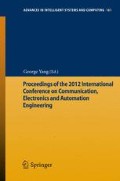Abstract
Workflow is one of the important technologies in enterprise business process automation. It has many advantages such as raising efficiency of business operation, improving resource utilization, increasing flexibility and adaptability of business execution and so on. However, traditional workflow systems have shortcomings of hard coding and flexibility. Based on the analysis of these shortcomings, a dynamic workflow system based on rule engine is put forward to enhance the flexibility of the system. This system has greatly improved the maintenance and flexibility.
Access this chapter
Tax calculation will be finalised at checkout
Purchases are for personal use only
Preview
Unable to display preview. Download preview PDF.
References
Mohan, C.: Recent trends in workflow management products, standards, and research (1997)
Alonso, G., Agrawal, D., Abbadi, E.: A Functionality and limitations of current workflow management systems. IEEE Expert 1(9), 12(5) (1997)
AmitSheth, M.R.: Modern Database Systems: The Object Model, Interoperability, and Beyond. ACM Press (1995)
van der Aalst, W.M.P.: Three good reasons for using a Petri-net-based workflow management system. Engineering and Computer Science 11(14), 179–201 (1996)
Wu, C., Deng, S.: Workflow System design and its realistic. Zhejiang University Press (2006)
Peng, L.: Rule engine principle analysis. FuJian Computer (9), 42–45 (2006)
Pierkakalo. Clinical Pathway (OL), http://baike.baidu.com/view/2109245.html
Cheng, M.: Research and the design of the dynamically workflow model based on rules engine. Wuhan Technology University (2009)
Li, G.: Integration Spting+Structs+Hibernate Application developing. Tsinghua University Press (2007)
Author information
Authors and Affiliations
Editor information
Editors and Affiliations
Rights and permissions
Copyright information
© 2013 Springer-Verlag Berlin Heidelberg
About this paper
Cite this paper
Tongchuan, L., Deyu, Q. (2013). Dynamic Workflow of Clinical Pathway System. In: Yang, G. (eds) Proceedings of the 2012 International Conference on Communication, Electronics and Automation Engineering. Advances in Intelligent Systems and Computing, vol 181. Springer, Berlin, Heidelberg. https://doi.org/10.1007/978-3-642-31698-2_16
Download citation
DOI: https://doi.org/10.1007/978-3-642-31698-2_16
Publisher Name: Springer, Berlin, Heidelberg
Print ISBN: 978-3-642-31697-5
Online ISBN: 978-3-642-31698-2
eBook Packages: EngineeringEngineering (R0)

